Report: Effects of Employee Engagement in UK Organizations (Tesco)
VerifiedAdded on 2022/09/01
|29
|4647
|24
Report
AI Summary
This report critically evaluates the effects of employee engagement within Tesco, a UK-based retail organization. The study investigates the relationship between employee engagement and various organizational outcomes, including job performance, employee satisfaction, and employee retention. The research employs both secondary and primary data collection methods, including a survey conducted within Tesco, to analyze the strategies used by the company to enhance employee engagement. The report explores various techniques such as entertainment programs, benefits, feedback mechanisms, wellness policies, and mentoring programs. The findings highlight the importance of employee engagement in reducing turnover, improving productivity, and fostering a positive work environment. The report also reviews the literature on employee engagement, its importance, and its impact on job performance, providing recommendations for further improvements in employee engagement strategies within Tesco and similar organizations. The report concludes by emphasizing the significance of employee engagement as a key strategy for organizational success in the competitive retail sector.
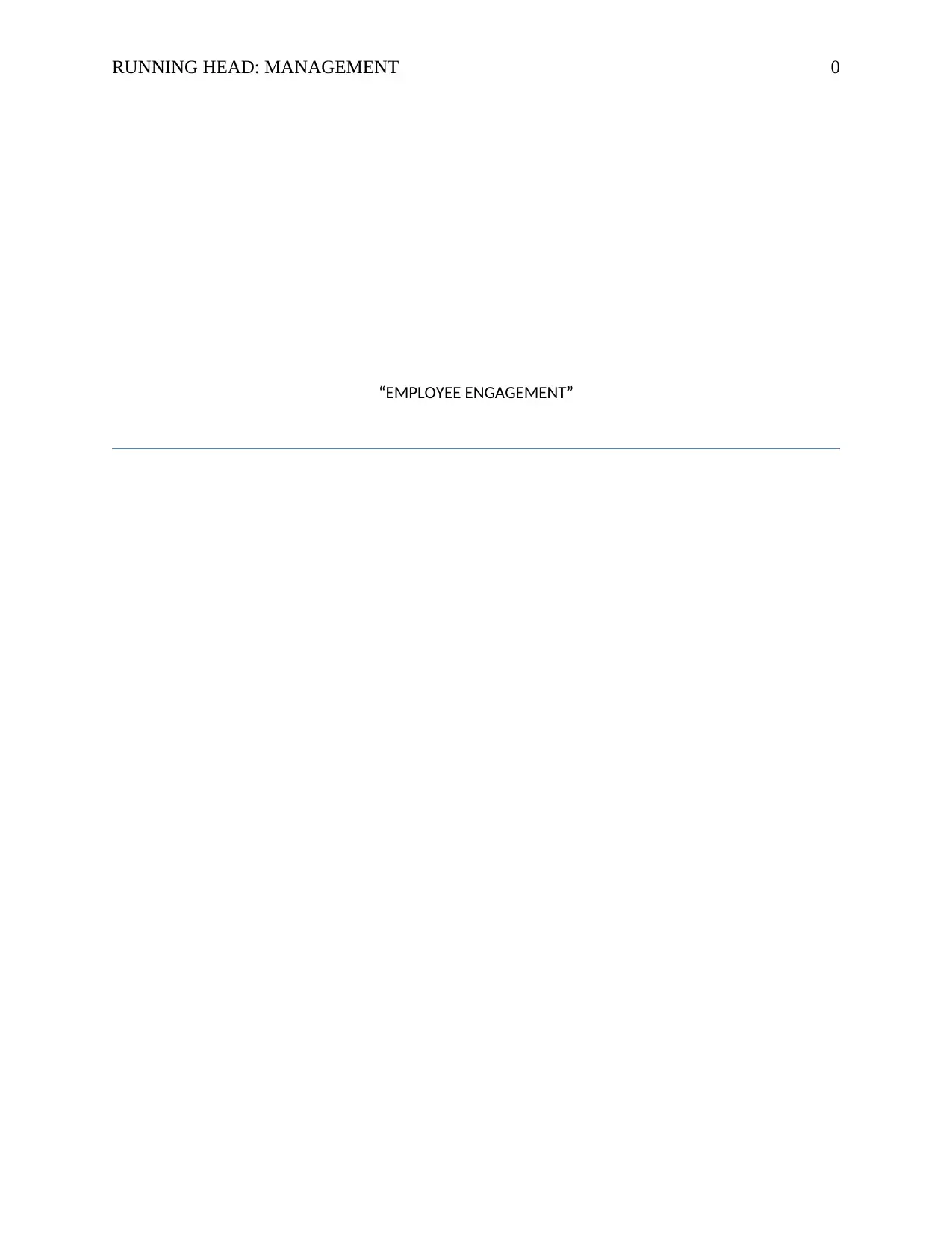
RUNNING HEAD: MANAGEMENT 0
“EMPLOYEE ENGAGEMENT”
“EMPLOYEE ENGAGEMENT”
Paraphrase This Document
Need a fresh take? Get an instant paraphrase of this document with our AI Paraphraser
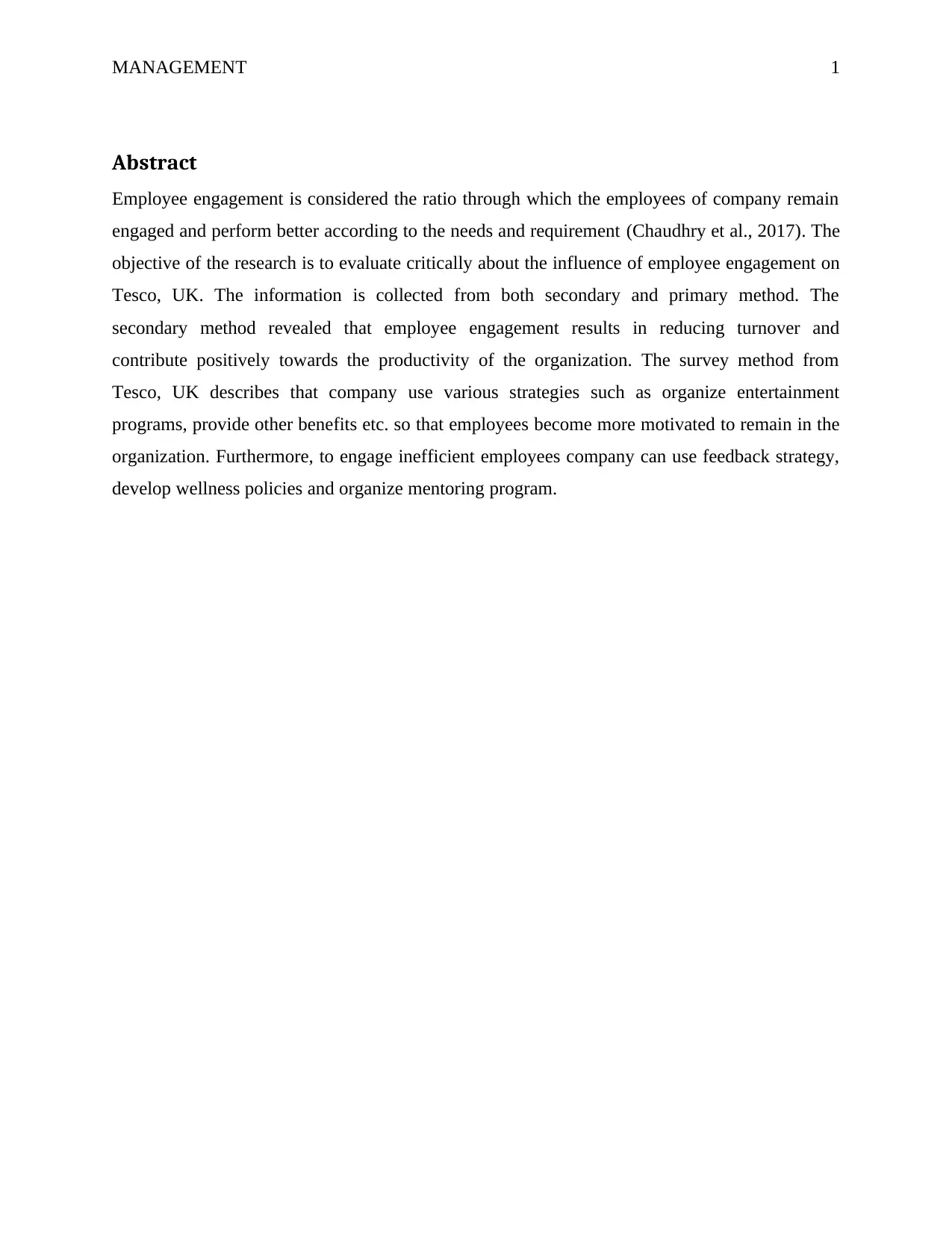
MANAGEMENT 1
Abstract
Employee engagement is considered the ratio through which the employees of company remain
engaged and perform better according to the needs and requirement (Chaudhry et al., 2017). The
objective of the research is to evaluate critically about the influence of employee engagement on
Tesco, UK. The information is collected from both secondary and primary method. The
secondary method revealed that employee engagement results in reducing turnover and
contribute positively towards the productivity of the organization. The survey method from
Tesco, UK describes that company use various strategies such as organize entertainment
programs, provide other benefits etc. so that employees become more motivated to remain in the
organization. Furthermore, to engage inefficient employees company can use feedback strategy,
develop wellness policies and organize mentoring program.
Abstract
Employee engagement is considered the ratio through which the employees of company remain
engaged and perform better according to the needs and requirement (Chaudhry et al., 2017). The
objective of the research is to evaluate critically about the influence of employee engagement on
Tesco, UK. The information is collected from both secondary and primary method. The
secondary method revealed that employee engagement results in reducing turnover and
contribute positively towards the productivity of the organization. The survey method from
Tesco, UK describes that company use various strategies such as organize entertainment
programs, provide other benefits etc. so that employees become more motivated to remain in the
organization. Furthermore, to engage inefficient employees company can use feedback strategy,
develop wellness policies and organize mentoring program.
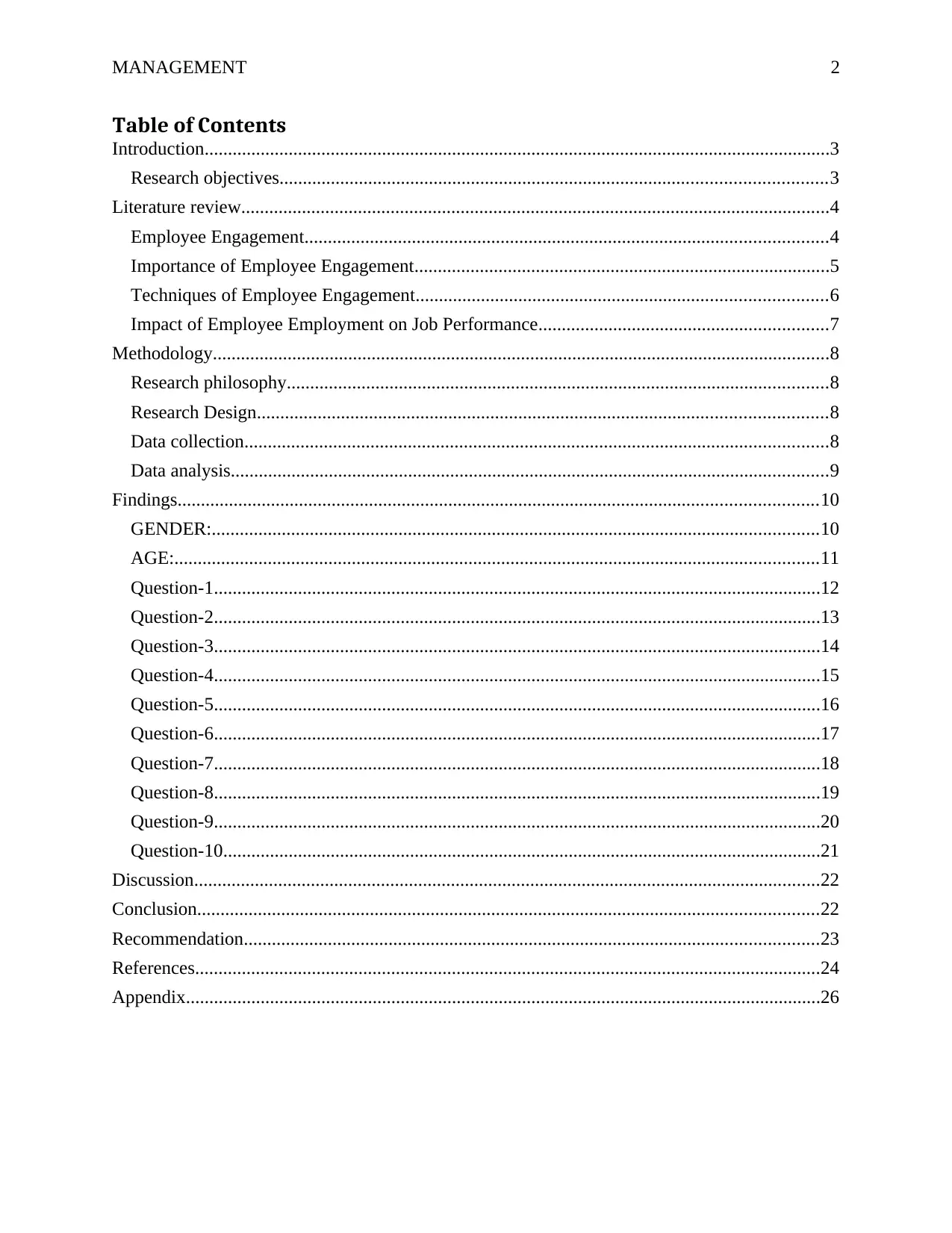
MANAGEMENT 2
Table of Contents
Introduction......................................................................................................................................3
Research objectives.....................................................................................................................3
Literature review..............................................................................................................................4
Employee Engagement................................................................................................................4
Importance of Employee Engagement.........................................................................................5
Techniques of Employee Engagement........................................................................................6
Impact of Employee Employment on Job Performance..............................................................7
Methodology....................................................................................................................................8
Research philosophy....................................................................................................................8
Research Design..........................................................................................................................8
Data collection.............................................................................................................................8
Data analysis................................................................................................................................9
Findings.........................................................................................................................................10
GENDER:..................................................................................................................................10
AGE:..........................................................................................................................................11
Question-1..................................................................................................................................12
Question-2..................................................................................................................................13
Question-3..................................................................................................................................14
Question-4..................................................................................................................................15
Question-5..................................................................................................................................16
Question-6..................................................................................................................................17
Question-7..................................................................................................................................18
Question-8..................................................................................................................................19
Question-9..................................................................................................................................20
Question-10................................................................................................................................21
Discussion......................................................................................................................................22
Conclusion.....................................................................................................................................22
Recommendation...........................................................................................................................23
References......................................................................................................................................24
Appendix........................................................................................................................................26
Table of Contents
Introduction......................................................................................................................................3
Research objectives.....................................................................................................................3
Literature review..............................................................................................................................4
Employee Engagement................................................................................................................4
Importance of Employee Engagement.........................................................................................5
Techniques of Employee Engagement........................................................................................6
Impact of Employee Employment on Job Performance..............................................................7
Methodology....................................................................................................................................8
Research philosophy....................................................................................................................8
Research Design..........................................................................................................................8
Data collection.............................................................................................................................8
Data analysis................................................................................................................................9
Findings.........................................................................................................................................10
GENDER:..................................................................................................................................10
AGE:..........................................................................................................................................11
Question-1..................................................................................................................................12
Question-2..................................................................................................................................13
Question-3..................................................................................................................................14
Question-4..................................................................................................................................15
Question-5..................................................................................................................................16
Question-6..................................................................................................................................17
Question-7..................................................................................................................................18
Question-8..................................................................................................................................19
Question-9..................................................................................................................................20
Question-10................................................................................................................................21
Discussion......................................................................................................................................22
Conclusion.....................................................................................................................................22
Recommendation...........................................................................................................................23
References......................................................................................................................................24
Appendix........................................................................................................................................26
⊘ This is a preview!⊘
Do you want full access?
Subscribe today to unlock all pages.

Trusted by 1+ million students worldwide
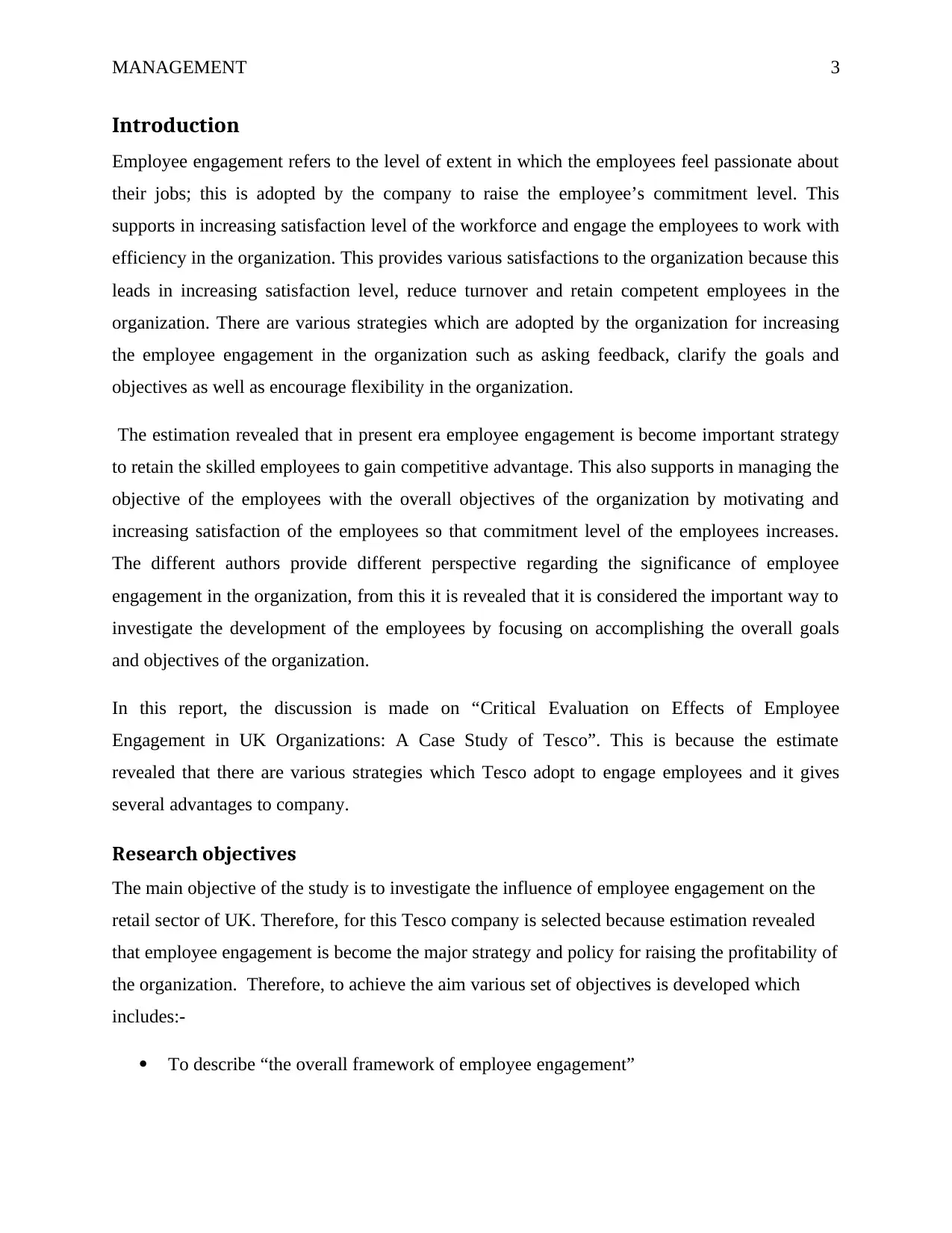
MANAGEMENT 3
Introduction
Employee engagement refers to the level of extent in which the employees feel passionate about
their jobs; this is adopted by the company to raise the employee’s commitment level. This
supports in increasing satisfaction level of the workforce and engage the employees to work with
efficiency in the organization. This provides various satisfactions to the organization because this
leads in increasing satisfaction level, reduce turnover and retain competent employees in the
organization. There are various strategies which are adopted by the organization for increasing
the employee engagement in the organization such as asking feedback, clarify the goals and
objectives as well as encourage flexibility in the organization.
The estimation revealed that in present era employee engagement is become important strategy
to retain the skilled employees to gain competitive advantage. This also supports in managing the
objective of the employees with the overall objectives of the organization by motivating and
increasing satisfaction of the employees so that commitment level of the employees increases.
The different authors provide different perspective regarding the significance of employee
engagement in the organization, from this it is revealed that it is considered the important way to
investigate the development of the employees by focusing on accomplishing the overall goals
and objectives of the organization.
In this report, the discussion is made on “Critical Evaluation on Effects of Employee
Engagement in UK Organizations: A Case Study of Tesco”. This is because the estimate
revealed that there are various strategies which Tesco adopt to engage employees and it gives
several advantages to company.
Research objectives
The main objective of the study is to investigate the influence of employee engagement on the
retail sector of UK. Therefore, for this Tesco company is selected because estimation revealed
that employee engagement is become the major strategy and policy for raising the profitability of
the organization. Therefore, to achieve the aim various set of objectives is developed which
includes:-
To describe “the overall framework of employee engagement”
Introduction
Employee engagement refers to the level of extent in which the employees feel passionate about
their jobs; this is adopted by the company to raise the employee’s commitment level. This
supports in increasing satisfaction level of the workforce and engage the employees to work with
efficiency in the organization. This provides various satisfactions to the organization because this
leads in increasing satisfaction level, reduce turnover and retain competent employees in the
organization. There are various strategies which are adopted by the organization for increasing
the employee engagement in the organization such as asking feedback, clarify the goals and
objectives as well as encourage flexibility in the organization.
The estimation revealed that in present era employee engagement is become important strategy
to retain the skilled employees to gain competitive advantage. This also supports in managing the
objective of the employees with the overall objectives of the organization by motivating and
increasing satisfaction of the employees so that commitment level of the employees increases.
The different authors provide different perspective regarding the significance of employee
engagement in the organization, from this it is revealed that it is considered the important way to
investigate the development of the employees by focusing on accomplishing the overall goals
and objectives of the organization.
In this report, the discussion is made on “Critical Evaluation on Effects of Employee
Engagement in UK Organizations: A Case Study of Tesco”. This is because the estimate
revealed that there are various strategies which Tesco adopt to engage employees and it gives
several advantages to company.
Research objectives
The main objective of the study is to investigate the influence of employee engagement on the
retail sector of UK. Therefore, for this Tesco company is selected because estimation revealed
that employee engagement is become the major strategy and policy for raising the profitability of
the organization. Therefore, to achieve the aim various set of objectives is developed which
includes:-
To describe “the overall framework of employee engagement”
Paraphrase This Document
Need a fresh take? Get an instant paraphrase of this document with our AI Paraphraser
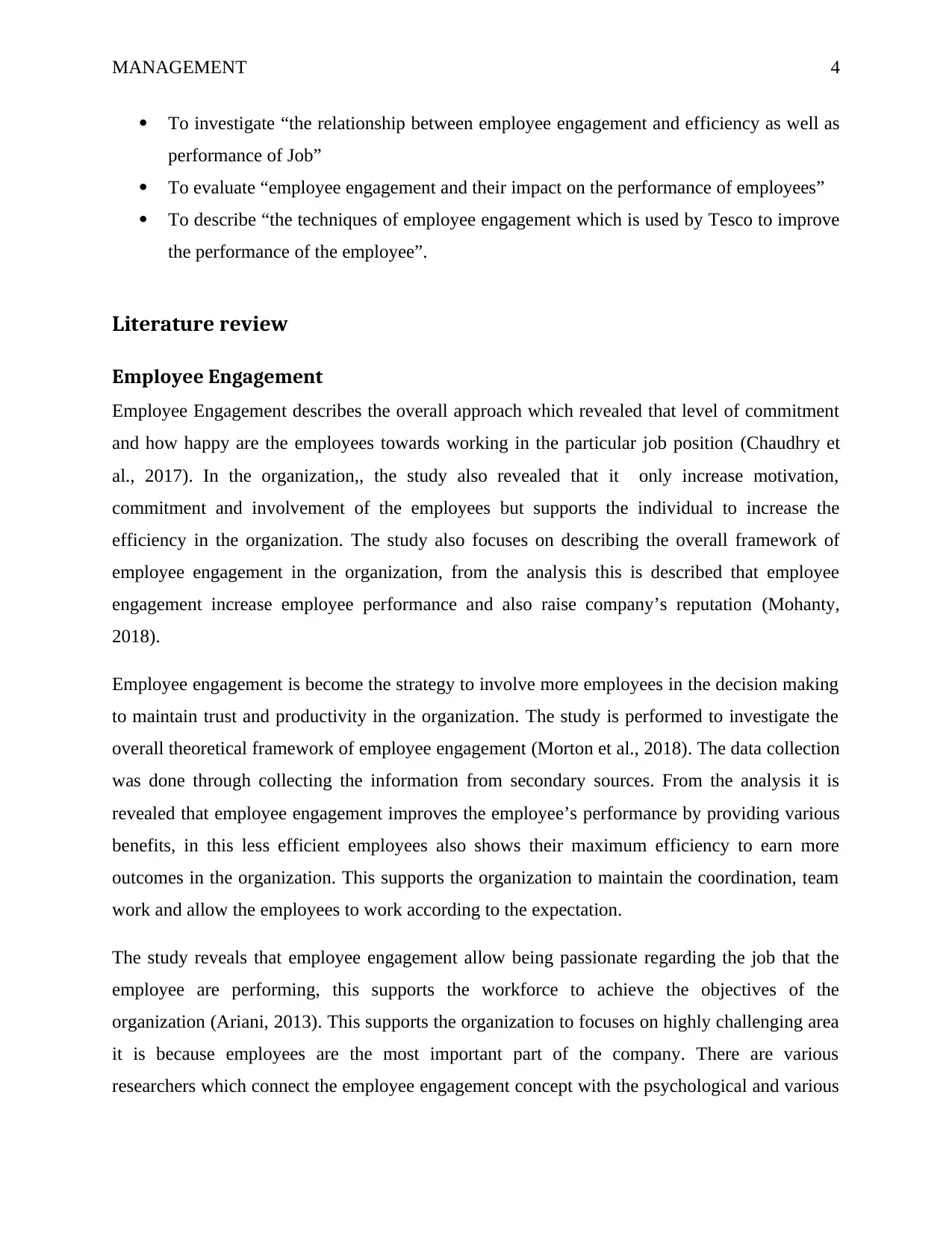
MANAGEMENT 4
To investigate “the relationship between employee engagement and efficiency as well as
performance of Job”
To evaluate “employee engagement and their impact on the performance of employees”
To describe “the techniques of employee engagement which is used by Tesco to improve
the performance of the employee”.
Literature review
Employee Engagement
Employee Engagement describes the overall approach which revealed that level of commitment
and how happy are the employees towards working in the particular job position (Chaudhry et
al., 2017). In the organization,, the study also revealed that it only increase motivation,
commitment and involvement of the employees but supports the individual to increase the
efficiency in the organization. The study also focuses on describing the overall framework of
employee engagement in the organization, from the analysis this is described that employee
engagement increase employee performance and also raise company’s reputation (Mohanty,
2018).
Employee engagement is become the strategy to involve more employees in the decision making
to maintain trust and productivity in the organization. The study is performed to investigate the
overall theoretical framework of employee engagement (Morton et al., 2018). The data collection
was done through collecting the information from secondary sources. From the analysis it is
revealed that employee engagement improves the employee’s performance by providing various
benefits, in this less efficient employees also shows their maximum efficiency to earn more
outcomes in the organization. This supports the organization to maintain the coordination, team
work and allow the employees to work according to the expectation.
The study reveals that employee engagement allow being passionate regarding the job that the
employee are performing, this supports the workforce to achieve the objectives of the
organization (Ariani, 2013). This supports the organization to focuses on highly challenging area
it is because employees are the most important part of the company. There are various
researchers which connect the employee engagement concept with the psychological and various
To investigate “the relationship between employee engagement and efficiency as well as
performance of Job”
To evaluate “employee engagement and their impact on the performance of employees”
To describe “the techniques of employee engagement which is used by Tesco to improve
the performance of the employee”.
Literature review
Employee Engagement
Employee Engagement describes the overall approach which revealed that level of commitment
and how happy are the employees towards working in the particular job position (Chaudhry et
al., 2017). In the organization,, the study also revealed that it only increase motivation,
commitment and involvement of the employees but supports the individual to increase the
efficiency in the organization. The study also focuses on describing the overall framework of
employee engagement in the organization, from the analysis this is described that employee
engagement increase employee performance and also raise company’s reputation (Mohanty,
2018).
Employee engagement is become the strategy to involve more employees in the decision making
to maintain trust and productivity in the organization. The study is performed to investigate the
overall theoretical framework of employee engagement (Morton et al., 2018). The data collection
was done through collecting the information from secondary sources. From the analysis it is
revealed that employee engagement improves the employee’s performance by providing various
benefits, in this less efficient employees also shows their maximum efficiency to earn more
outcomes in the organization. This supports the organization to maintain the coordination, team
work and allow the employees to work according to the expectation.
The study reveals that employee engagement allow being passionate regarding the job that the
employee are performing, this supports the workforce to achieve the objectives of the
organization (Ariani, 2013). This supports the organization to focuses on highly challenging area
it is because employees are the most important part of the company. There are various
researchers which connect the employee engagement concept with the psychological and various
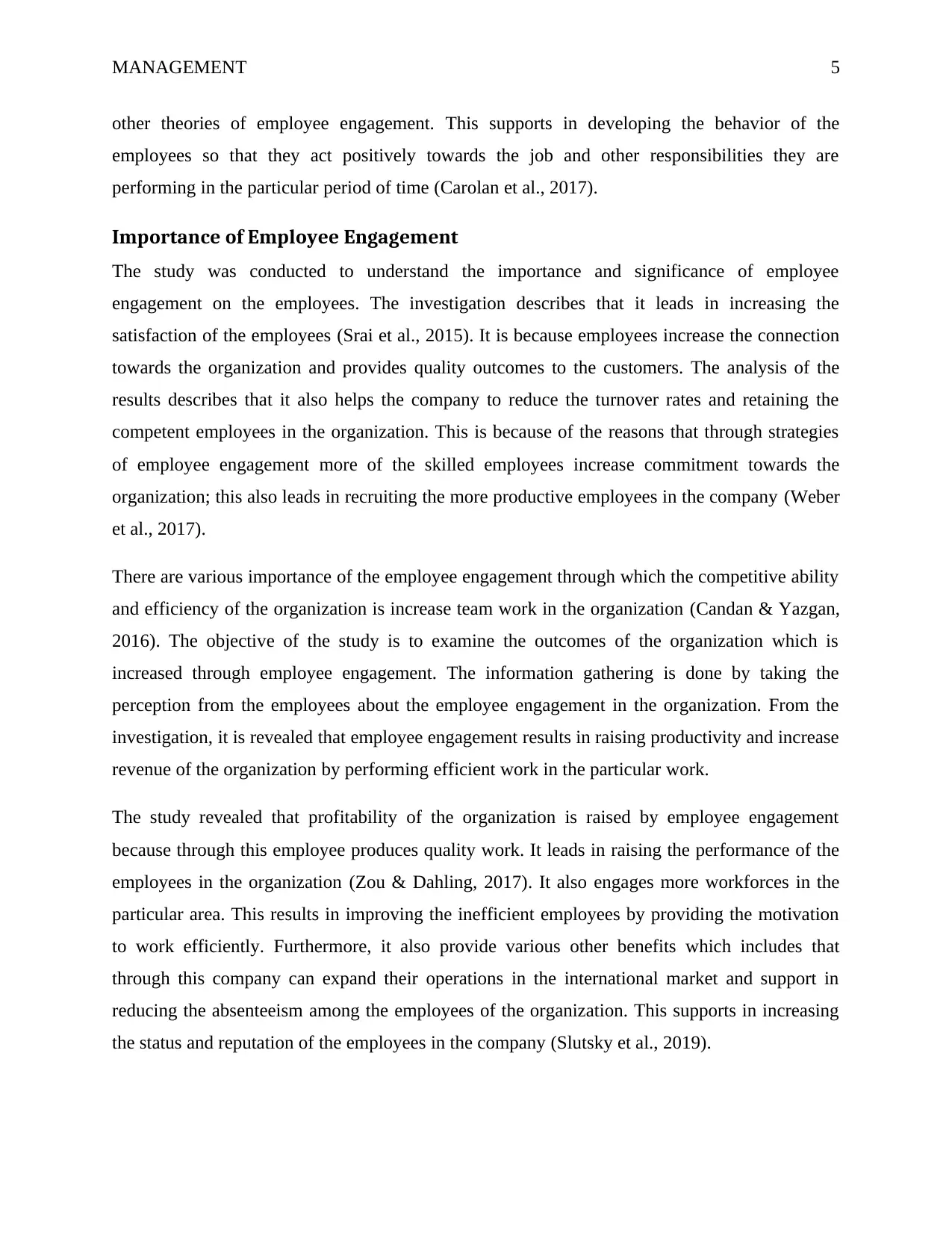
MANAGEMENT 5
other theories of employee engagement. This supports in developing the behavior of the
employees so that they act positively towards the job and other responsibilities they are
performing in the particular period of time (Carolan et al., 2017).
Importance of Employee Engagement
The study was conducted to understand the importance and significance of employee
engagement on the employees. The investigation describes that it leads in increasing the
satisfaction of the employees (Srai et al., 2015). It is because employees increase the connection
towards the organization and provides quality outcomes to the customers. The analysis of the
results describes that it also helps the company to reduce the turnover rates and retaining the
competent employees in the organization. This is because of the reasons that through strategies
of employee engagement more of the skilled employees increase commitment towards the
organization; this also leads in recruiting the more productive employees in the company (Weber
et al., 2017).
There are various importance of the employee engagement through which the competitive ability
and efficiency of the organization is increase team work in the organization (Candan & Yazgan,
2016). The objective of the study is to examine the outcomes of the organization which is
increased through employee engagement. The information gathering is done by taking the
perception from the employees about the employee engagement in the organization. From the
investigation, it is revealed that employee engagement results in raising productivity and increase
revenue of the organization by performing efficient work in the particular work.
The study revealed that profitability of the organization is raised by employee engagement
because through this employee produces quality work. It leads in raising the performance of the
employees in the organization (Zou & Dahling, 2017). It also engages more workforces in the
particular area. This results in improving the inefficient employees by providing the motivation
to work efficiently. Furthermore, it also provide various other benefits which includes that
through this company can expand their operations in the international market and support in
reducing the absenteeism among the employees of the organization. This supports in increasing
the status and reputation of the employees in the company (Slutsky et al., 2019).
other theories of employee engagement. This supports in developing the behavior of the
employees so that they act positively towards the job and other responsibilities they are
performing in the particular period of time (Carolan et al., 2017).
Importance of Employee Engagement
The study was conducted to understand the importance and significance of employee
engagement on the employees. The investigation describes that it leads in increasing the
satisfaction of the employees (Srai et al., 2015). It is because employees increase the connection
towards the organization and provides quality outcomes to the customers. The analysis of the
results describes that it also helps the company to reduce the turnover rates and retaining the
competent employees in the organization. This is because of the reasons that through strategies
of employee engagement more of the skilled employees increase commitment towards the
organization; this also leads in recruiting the more productive employees in the company (Weber
et al., 2017).
There are various importance of the employee engagement through which the competitive ability
and efficiency of the organization is increase team work in the organization (Candan & Yazgan,
2016). The objective of the study is to examine the outcomes of the organization which is
increased through employee engagement. The information gathering is done by taking the
perception from the employees about the employee engagement in the organization. From the
investigation, it is revealed that employee engagement results in raising productivity and increase
revenue of the organization by performing efficient work in the particular work.
The study revealed that profitability of the organization is raised by employee engagement
because through this employee produces quality work. It leads in raising the performance of the
employees in the organization (Zou & Dahling, 2017). It also engages more workforces in the
particular area. This results in improving the inefficient employees by providing the motivation
to work efficiently. Furthermore, it also provide various other benefits which includes that
through this company can expand their operations in the international market and support in
reducing the absenteeism among the employees of the organization. This supports in increasing
the status and reputation of the employees in the company (Slutsky et al., 2019).
⊘ This is a preview!⊘
Do you want full access?
Subscribe today to unlock all pages.

Trusted by 1+ million students worldwide
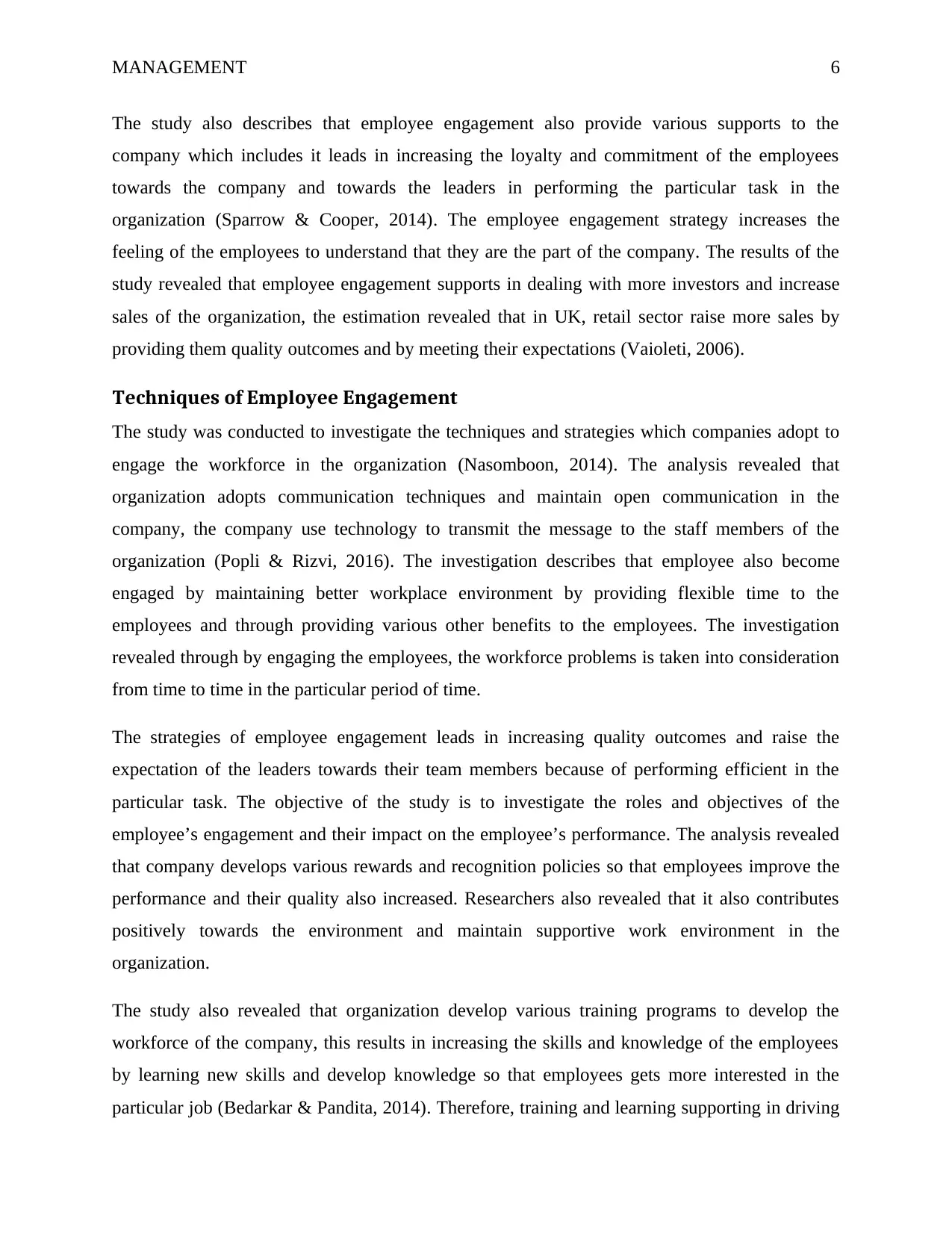
MANAGEMENT 6
The study also describes that employee engagement also provide various supports to the
company which includes it leads in increasing the loyalty and commitment of the employees
towards the company and towards the leaders in performing the particular task in the
organization (Sparrow & Cooper, 2014). The employee engagement strategy increases the
feeling of the employees to understand that they are the part of the company. The results of the
study revealed that employee engagement supports in dealing with more investors and increase
sales of the organization, the estimation revealed that in UK, retail sector raise more sales by
providing them quality outcomes and by meeting their expectations (Vaioleti, 2006).
Techniques of Employee Engagement
The study was conducted to investigate the techniques and strategies which companies adopt to
engage the workforce in the organization (Nasomboon, 2014). The analysis revealed that
organization adopts communication techniques and maintain open communication in the
company, the company use technology to transmit the message to the staff members of the
organization (Popli & Rizvi, 2016). The investigation describes that employee also become
engaged by maintaining better workplace environment by providing flexible time to the
employees and through providing various other benefits to the employees. The investigation
revealed through by engaging the employees, the workforce problems is taken into consideration
from time to time in the particular period of time.
The strategies of employee engagement leads in increasing quality outcomes and raise the
expectation of the leaders towards their team members because of performing efficient in the
particular task. The objective of the study is to investigate the roles and objectives of the
employee’s engagement and their impact on the employee’s performance. The analysis revealed
that company develops various rewards and recognition policies so that employees improve the
performance and their quality also increased. Researchers also revealed that it also contributes
positively towards the environment and maintain supportive work environment in the
organization.
The study also revealed that organization develop various training programs to develop the
workforce of the company, this results in increasing the skills and knowledge of the employees
by learning new skills and develop knowledge so that employees gets more interested in the
particular job (Bedarkar & Pandita, 2014). Therefore, training and learning supporting in driving
The study also describes that employee engagement also provide various supports to the
company which includes it leads in increasing the loyalty and commitment of the employees
towards the company and towards the leaders in performing the particular task in the
organization (Sparrow & Cooper, 2014). The employee engagement strategy increases the
feeling of the employees to understand that they are the part of the company. The results of the
study revealed that employee engagement supports in dealing with more investors and increase
sales of the organization, the estimation revealed that in UK, retail sector raise more sales by
providing them quality outcomes and by meeting their expectations (Vaioleti, 2006).
Techniques of Employee Engagement
The study was conducted to investigate the techniques and strategies which companies adopt to
engage the workforce in the organization (Nasomboon, 2014). The analysis revealed that
organization adopts communication techniques and maintain open communication in the
company, the company use technology to transmit the message to the staff members of the
organization (Popli & Rizvi, 2016). The investigation describes that employee also become
engaged by maintaining better workplace environment by providing flexible time to the
employees and through providing various other benefits to the employees. The investigation
revealed through by engaging the employees, the workforce problems is taken into consideration
from time to time in the particular period of time.
The strategies of employee engagement leads in increasing quality outcomes and raise the
expectation of the leaders towards their team members because of performing efficient in the
particular task. The objective of the study is to investigate the roles and objectives of the
employee’s engagement and their impact on the employee’s performance. The analysis revealed
that company develops various rewards and recognition policies so that employees improve the
performance and their quality also increased. Researchers also revealed that it also contributes
positively towards the environment and maintain supportive work environment in the
organization.
The study also revealed that organization develop various training programs to develop the
workforce of the company, this results in increasing the skills and knowledge of the employees
by learning new skills and develop knowledge so that employees gets more interested in the
particular job (Bedarkar & Pandita, 2014). Therefore, training and learning supporting in driving
Paraphrase This Document
Need a fresh take? Get an instant paraphrase of this document with our AI Paraphraser
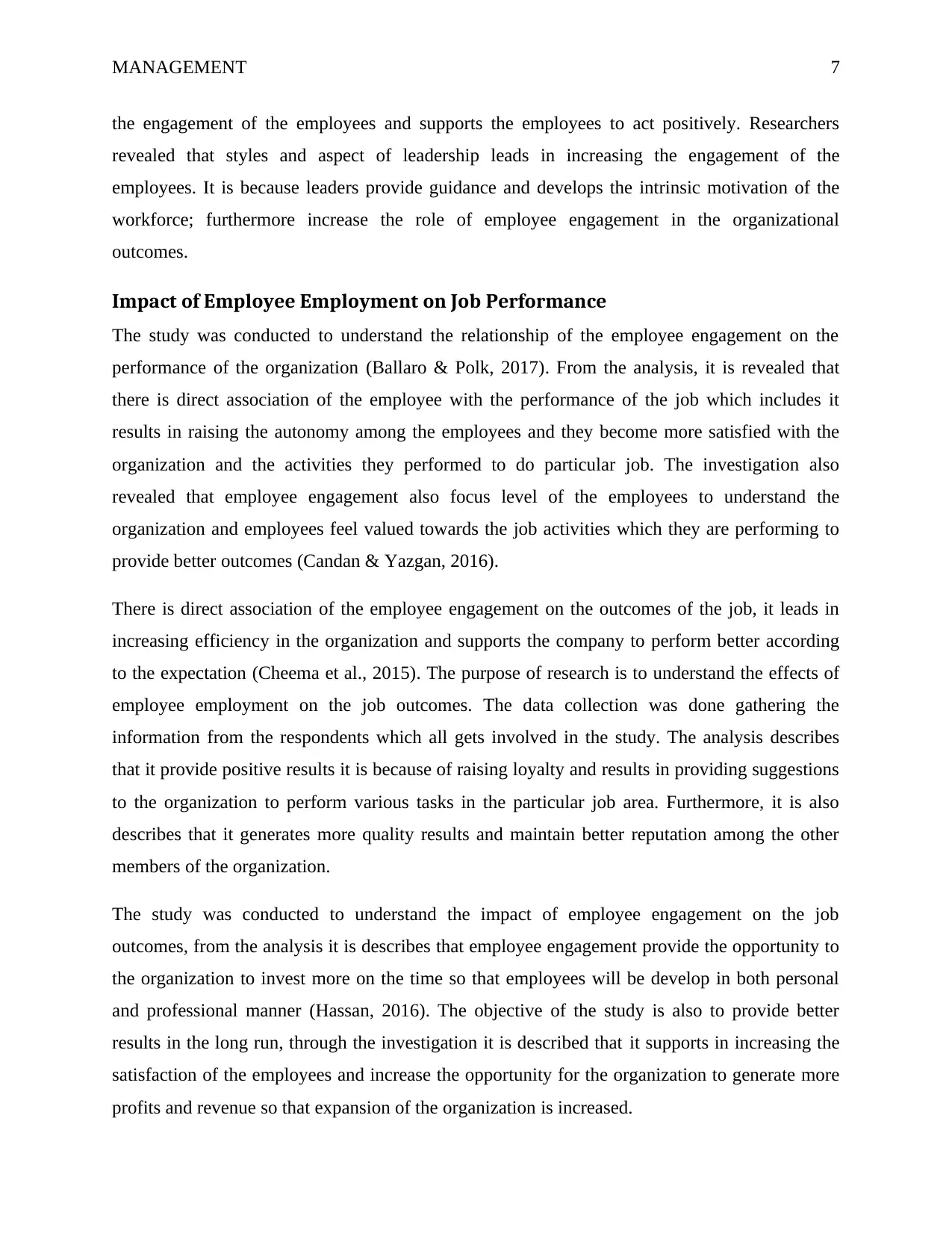
MANAGEMENT 7
the engagement of the employees and supports the employees to act positively. Researchers
revealed that styles and aspect of leadership leads in increasing the engagement of the
employees. It is because leaders provide guidance and develops the intrinsic motivation of the
workforce; furthermore increase the role of employee engagement in the organizational
outcomes.
Impact of Employee Employment on Job Performance
The study was conducted to understand the relationship of the employee engagement on the
performance of the organization (Ballaro & Polk, 2017). From the analysis, it is revealed that
there is direct association of the employee with the performance of the job which includes it
results in raising the autonomy among the employees and they become more satisfied with the
organization and the activities they performed to do particular job. The investigation also
revealed that employee engagement also focus level of the employees to understand the
organization and employees feel valued towards the job activities which they are performing to
provide better outcomes (Candan & Yazgan, 2016).
There is direct association of the employee engagement on the outcomes of the job, it leads in
increasing efficiency in the organization and supports the company to perform better according
to the expectation (Cheema et al., 2015). The purpose of research is to understand the effects of
employee employment on the job outcomes. The data collection was done gathering the
information from the respondents which all gets involved in the study. The analysis describes
that it provide positive results it is because of raising loyalty and results in providing suggestions
to the organization to perform various tasks in the particular job area. Furthermore, it is also
describes that it generates more quality results and maintain better reputation among the other
members of the organization.
The study was conducted to understand the impact of employee engagement on the job
outcomes, from the analysis it is describes that employee engagement provide the opportunity to
the organization to invest more on the time so that employees will be develop in both personal
and professional manner (Hassan, 2016). The objective of the study is also to provide better
results in the long run, through the investigation it is described that it supports in increasing the
satisfaction of the employees and increase the opportunity for the organization to generate more
profits and revenue so that expansion of the organization is increased.
the engagement of the employees and supports the employees to act positively. Researchers
revealed that styles and aspect of leadership leads in increasing the engagement of the
employees. It is because leaders provide guidance and develops the intrinsic motivation of the
workforce; furthermore increase the role of employee engagement in the organizational
outcomes.
Impact of Employee Employment on Job Performance
The study was conducted to understand the relationship of the employee engagement on the
performance of the organization (Ballaro & Polk, 2017). From the analysis, it is revealed that
there is direct association of the employee with the performance of the job which includes it
results in raising the autonomy among the employees and they become more satisfied with the
organization and the activities they performed to do particular job. The investigation also
revealed that employee engagement also focus level of the employees to understand the
organization and employees feel valued towards the job activities which they are performing to
provide better outcomes (Candan & Yazgan, 2016).
There is direct association of the employee engagement on the outcomes of the job, it leads in
increasing efficiency in the organization and supports the company to perform better according
to the expectation (Cheema et al., 2015). The purpose of research is to understand the effects of
employee employment on the job outcomes. The data collection was done gathering the
information from the respondents which all gets involved in the study. The analysis describes
that it provide positive results it is because of raising loyalty and results in providing suggestions
to the organization to perform various tasks in the particular job area. Furthermore, it is also
describes that it generates more quality results and maintain better reputation among the other
members of the organization.
The study was conducted to understand the impact of employee engagement on the job
outcomes, from the analysis it is describes that employee engagement provide the opportunity to
the organization to invest more on the time so that employees will be develop in both personal
and professional manner (Hassan, 2016). The objective of the study is also to provide better
results in the long run, through the investigation it is described that it supports in increasing the
satisfaction of the employees and increase the opportunity for the organization to generate more
profits and revenue so that expansion of the organization is increased.
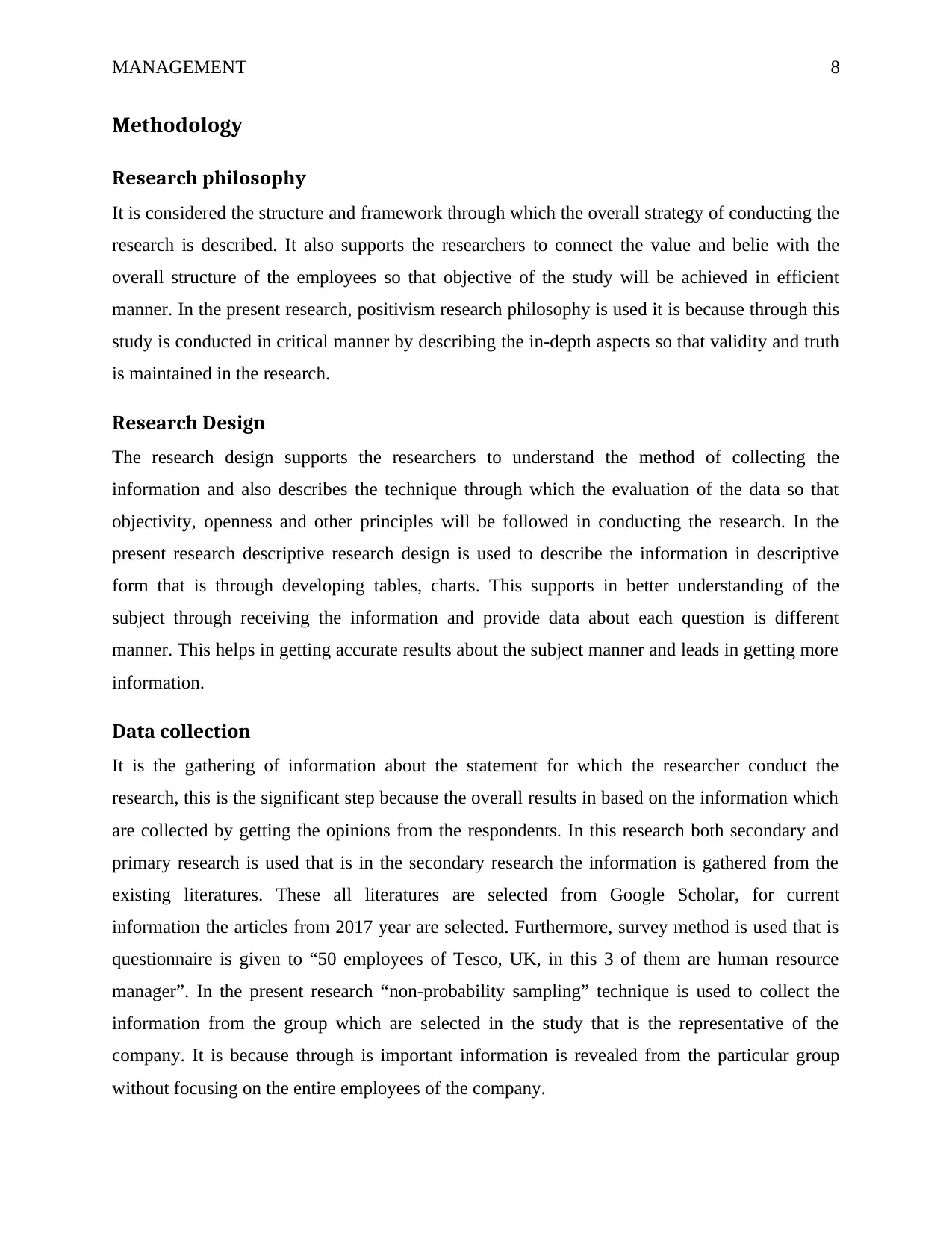
MANAGEMENT 8
Methodology
Research philosophy
It is considered the structure and framework through which the overall strategy of conducting the
research is described. It also supports the researchers to connect the value and belie with the
overall structure of the employees so that objective of the study will be achieved in efficient
manner. In the present research, positivism research philosophy is used it is because through this
study is conducted in critical manner by describing the in-depth aspects so that validity and truth
is maintained in the research.
Research Design
The research design supports the researchers to understand the method of collecting the
information and also describes the technique through which the evaluation of the data so that
objectivity, openness and other principles will be followed in conducting the research. In the
present research descriptive research design is used to describe the information in descriptive
form that is through developing tables, charts. This supports in better understanding of the
subject through receiving the information and provide data about each question is different
manner. This helps in getting accurate results about the subject manner and leads in getting more
information.
Data collection
It is the gathering of information about the statement for which the researcher conduct the
research, this is the significant step because the overall results in based on the information which
are collected by getting the opinions from the respondents. In this research both secondary and
primary research is used that is in the secondary research the information is gathered from the
existing literatures. These all literatures are selected from Google Scholar, for current
information the articles from 2017 year are selected. Furthermore, survey method is used that is
questionnaire is given to “50 employees of Tesco, UK, in this 3 of them are human resource
manager”. In the present research “non-probability sampling” technique is used to collect the
information from the group which are selected in the study that is the representative of the
company. It is because through is important information is revealed from the particular group
without focusing on the entire employees of the company.
Methodology
Research philosophy
It is considered the structure and framework through which the overall strategy of conducting the
research is described. It also supports the researchers to connect the value and belie with the
overall structure of the employees so that objective of the study will be achieved in efficient
manner. In the present research, positivism research philosophy is used it is because through this
study is conducted in critical manner by describing the in-depth aspects so that validity and truth
is maintained in the research.
Research Design
The research design supports the researchers to understand the method of collecting the
information and also describes the technique through which the evaluation of the data so that
objectivity, openness and other principles will be followed in conducting the research. In the
present research descriptive research design is used to describe the information in descriptive
form that is through developing tables, charts. This supports in better understanding of the
subject through receiving the information and provide data about each question is different
manner. This helps in getting accurate results about the subject manner and leads in getting more
information.
Data collection
It is the gathering of information about the statement for which the researcher conduct the
research, this is the significant step because the overall results in based on the information which
are collected by getting the opinions from the respondents. In this research both secondary and
primary research is used that is in the secondary research the information is gathered from the
existing literatures. These all literatures are selected from Google Scholar, for current
information the articles from 2017 year are selected. Furthermore, survey method is used that is
questionnaire is given to “50 employees of Tesco, UK, in this 3 of them are human resource
manager”. In the present research “non-probability sampling” technique is used to collect the
information from the group which are selected in the study that is the representative of the
company. It is because through is important information is revealed from the particular group
without focusing on the entire employees of the company.
⊘ This is a preview!⊘
Do you want full access?
Subscribe today to unlock all pages.

Trusted by 1+ million students worldwide
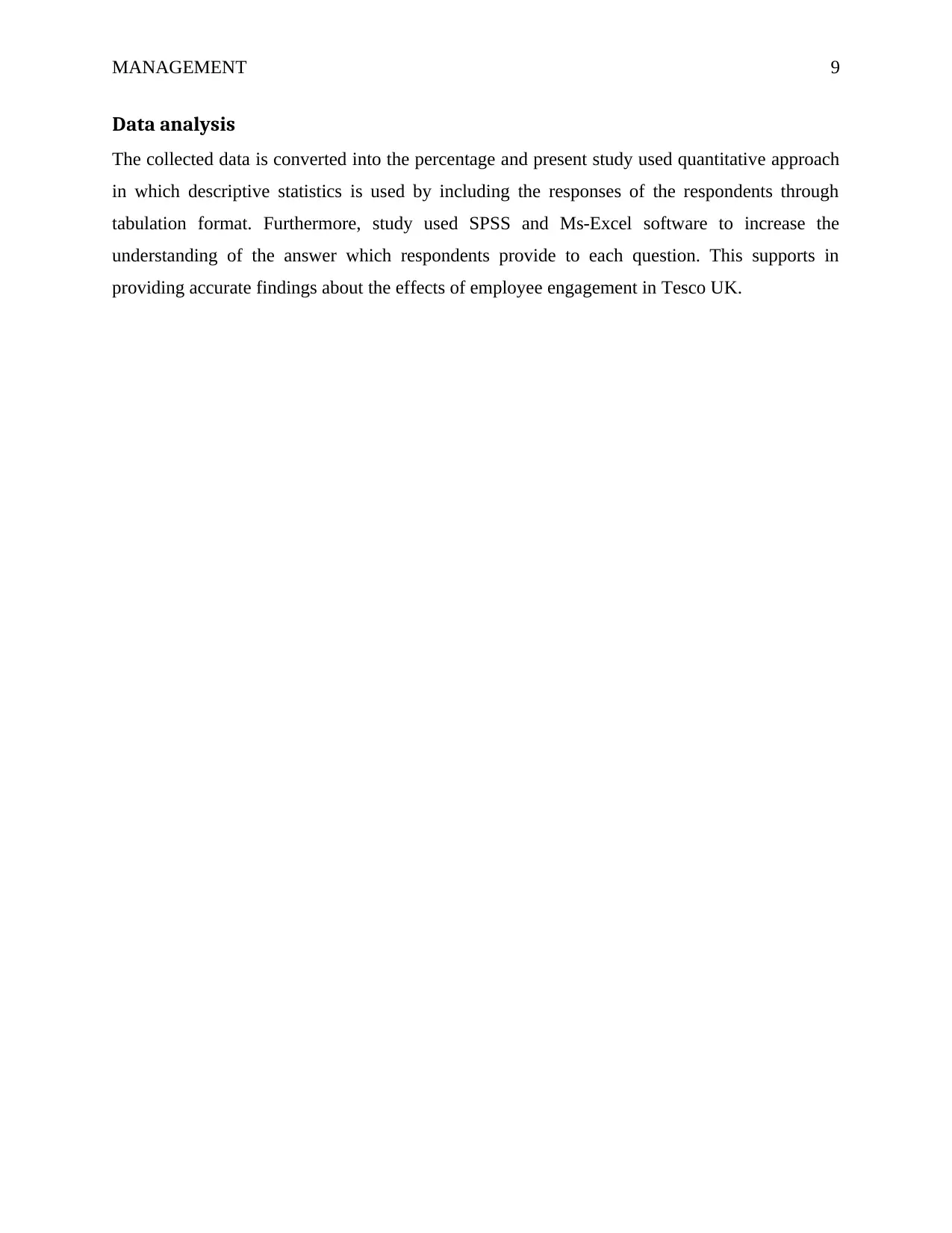
MANAGEMENT 9
Data analysis
The collected data is converted into the percentage and present study used quantitative approach
in which descriptive statistics is used by including the responses of the respondents through
tabulation format. Furthermore, study used SPSS and Ms-Excel software to increase the
understanding of the answer which respondents provide to each question. This supports in
providing accurate findings about the effects of employee engagement in Tesco UK.
Data analysis
The collected data is converted into the percentage and present study used quantitative approach
in which descriptive statistics is used by including the responses of the respondents through
tabulation format. Furthermore, study used SPSS and Ms-Excel software to increase the
understanding of the answer which respondents provide to each question. This supports in
providing accurate findings about the effects of employee engagement in Tesco UK.
Paraphrase This Document
Need a fresh take? Get an instant paraphrase of this document with our AI Paraphraser
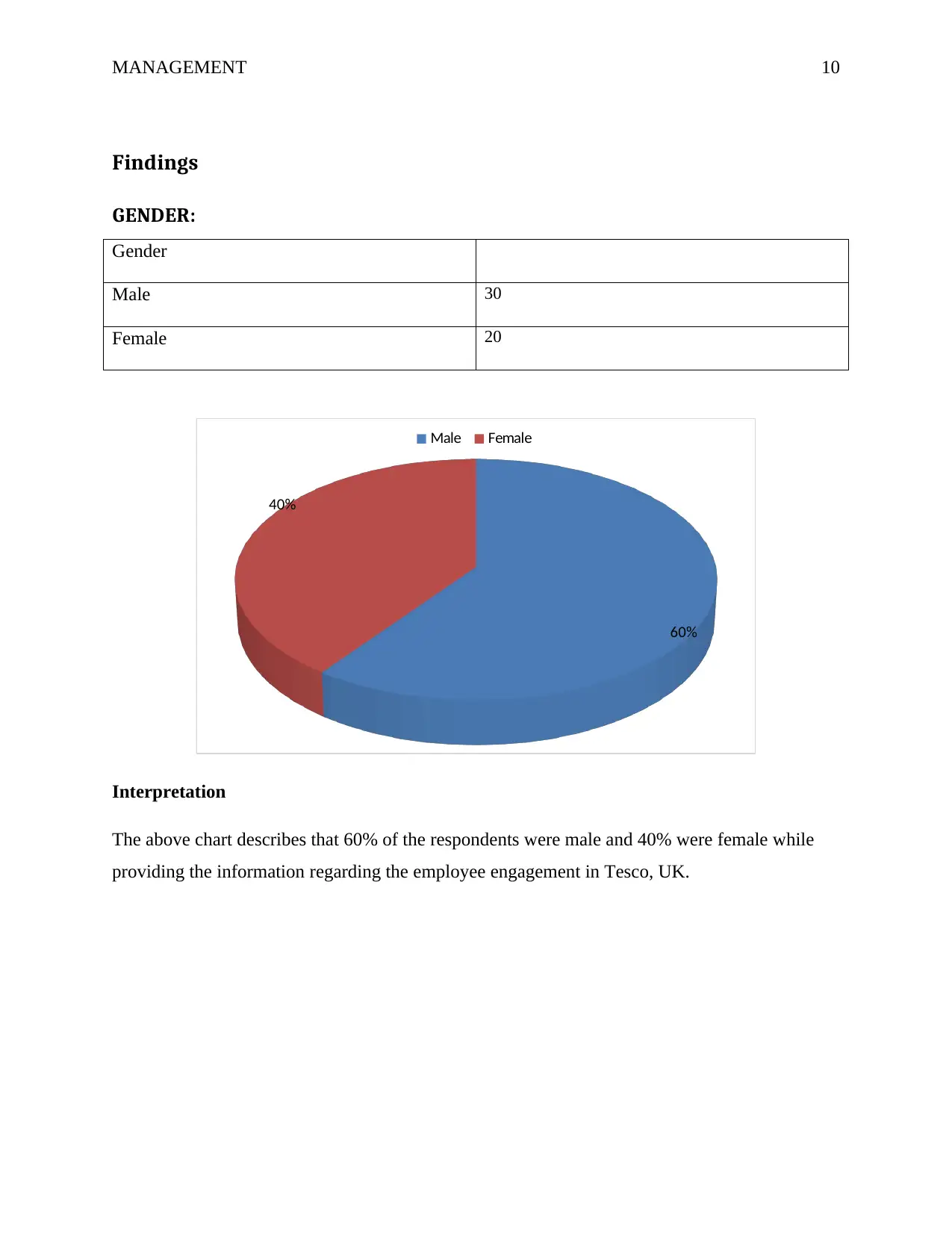
MANAGEMENT 10
Findings
GENDER:
Gender
Male 30
Female 20
60%
40%
Male Female
Interpretation
The above chart describes that 60% of the respondents were male and 40% were female while
providing the information regarding the employee engagement in Tesco, UK.
Findings
GENDER:
Gender
Male 30
Female 20
60%
40%
Male Female
Interpretation
The above chart describes that 60% of the respondents were male and 40% were female while
providing the information regarding the employee engagement in Tesco, UK.
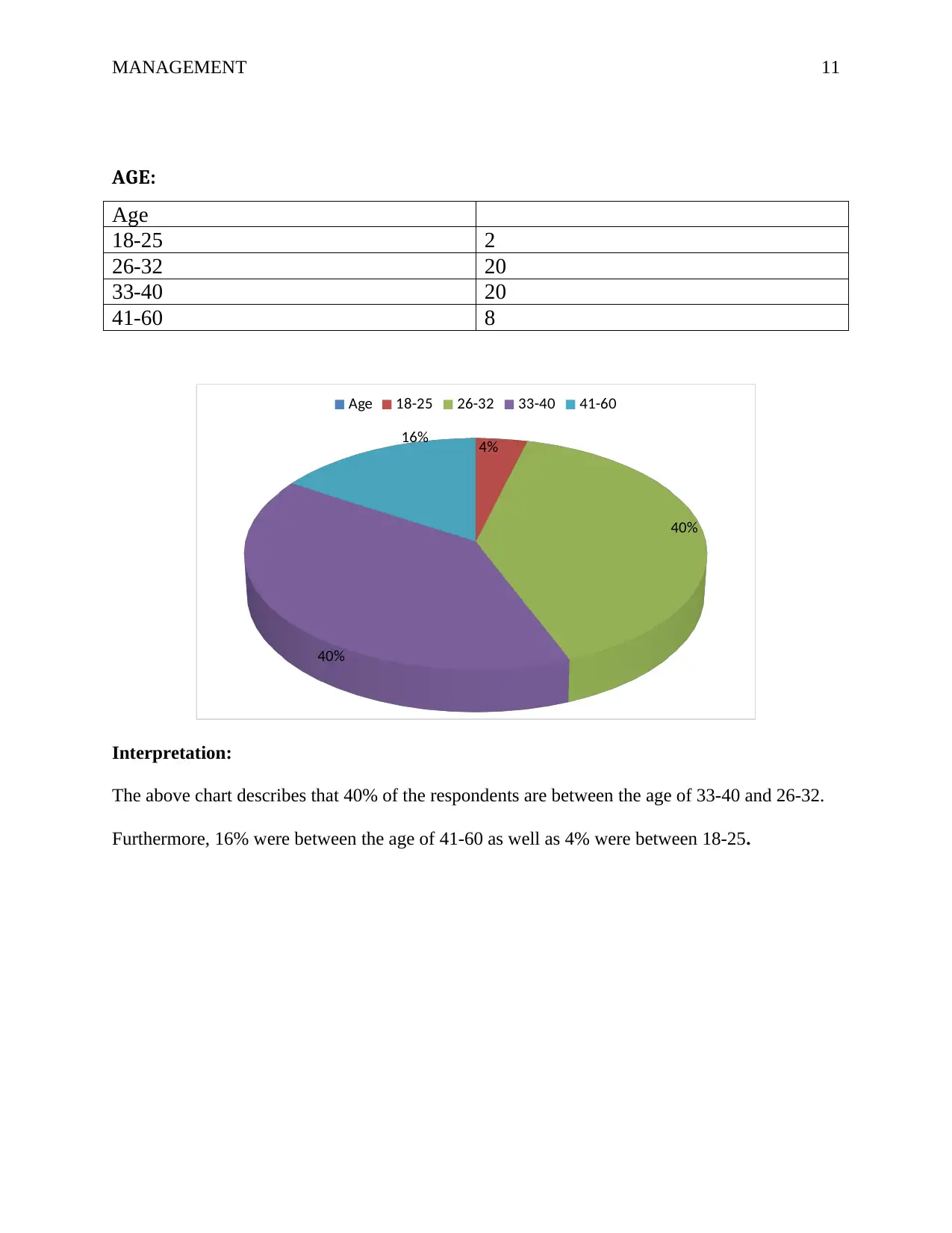
MANAGEMENT 11
AGE:
Age
18-25 2
26-32 20
33-40 20
41-60 8
4%
40%
40%
16%
Age 18-25 26-32 33-40 41-60
Interpretation:
The above chart describes that 40% of the respondents are between the age of 33-40 and 26-32.
Furthermore, 16% were between the age of 41-60 as well as 4% were between 18-25.
AGE:
Age
18-25 2
26-32 20
33-40 20
41-60 8
4%
40%
40%
16%
Age 18-25 26-32 33-40 41-60
Interpretation:
The above chart describes that 40% of the respondents are between the age of 33-40 and 26-32.
Furthermore, 16% were between the age of 41-60 as well as 4% were between 18-25.
⊘ This is a preview!⊘
Do you want full access?
Subscribe today to unlock all pages.

Trusted by 1+ million students worldwide
1 out of 29
Related Documents
Your All-in-One AI-Powered Toolkit for Academic Success.
+13062052269
info@desklib.com
Available 24*7 on WhatsApp / Email
![[object Object]](/_next/static/media/star-bottom.7253800d.svg)
Unlock your academic potential
Copyright © 2020–2025 A2Z Services. All Rights Reserved. Developed and managed by ZUCOL.




